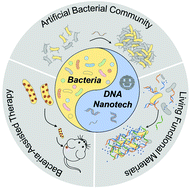Engineering bacterial surface interactions using DNA as a programmable material
Abstract
The diverse surface interactions and functions of a bacterium play an important role in cell signaling, host infection, and colony formation. To understand and synthetically control the biological functions of individual cells as well as the whole community, there is growing attention on the development of chemical and biological tools that can integrate artificial functional motifs onto the bacterial surface to replace the native interactions, enabling a variety of applications in biosynthesis, environmental protection, and human health. Among all these functional motifs, DNA emerges as a powerful tool that can precisely control bacterial interactions at the bio-interface due to its programmability and biorecognition properties. Compared with conventional chemical and genetic approaches, the sequence-specific Watson–Crick interaction enables almost unlimited programmability in DNA nanostructures, realizing one base-pair spatial control and bio-responsive properties. This highlight aims to provide an overview on this emerging research topic of DNA-engineered bacterial interactions from the aspect of synthetic chemists. We start with the introduction of native bacterial surface ligands and established synthetic approaches to install artificial ligands, including direct modification, metabolic engineering, and genetic engineering. A brief overview of DNA nanotechnology, reported DNA–bacteria conjugation chemistries, and several examples of DNA-engineered bacteria are included in this highlight. The future perspectives and challenges in this field are also discussed, including the development of dynamic bacterial surface chemistry, assembly of programmable multicellular community, and realization of bacteria-based theranostic agents and synthetic microbiota as long-term goals.

- This article is part of the themed collection: 2021 Emerging Investigators


 Please wait while we load your content...
Please wait while we load your content...